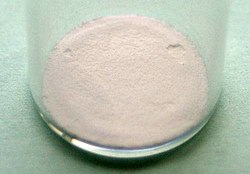Top Qs
Timeline
Chat
Perspective
Boron trioxide
Chemical compound From Wikipedia, the free encyclopedia
Remove ads
Boron trioxide or diboron trioxide is the oxide of boron with the formula B2O3. It is a colorless transparent solid, almost always glassy (amorphous), which can be crystallized only with great difficulty. It is also called boric oxide[6] or boria.[7] It has many important industrial applications, chiefly in ceramics as a flux for glazes and enamels and in the production of glasses.
Remove ads
Structure
Summarize
Perspective
Boron trioxide has three known forms, one amorphous and two crystalline.
Amorphous form
The amorphous form (g-B2O3) is by far the most common. It is thought to be composed of boroxol rings which are six-membered rings composed of alternating 3-coordinate boron and 2-coordinate oxygen.
Because of the difficulty of building disordered models at the correct density with many boroxol rings, this view was initially controversial, but such models have recently been constructed and exhibit properties in excellent agreement with experiment.[8][9] It is now recognized, from experimental and theoretical studies,[10][11][12][13][14] that the fraction of boron atoms belonging to boroxol rings in glassy B2O3 is somewhere between 0.73 and 0.83, with 0.75 = 3/4 corresponding to a 1:1 ratio between ring and non-ring units. The number of boroxol rings decays in the liquid state with increasing temperature.[15][16]
Crystalline α form
The crystalline form (α-B2O3) is exclusively composed of BO3 triangles. Its crystal structure was initially believed to be the enantiomorphic space groups P31(#144) and P32(#145), like γ-glycine;[17][18] but was later revised to the enantiomorphic space groups P3121(#152) and P3221(#154) in the trigonal crystal system, like α-quartz[19]
Crystallization of α-B2O3 from the molten state at ambient pressure is strongly kinetically disfavored (compare liquid and crystal densities). It can be obtained with prolonged annealing of the amorphous solid ~200 °C under at least 10 kbar of pressure.[20][1]
Crystalline β form
The trigonal network undergoes a coesite-like transformation to monoclinic β-B2O3 at several gigapascals (9.5 GPa).[21]
Remove ads
Preparation
Boron trioxide is produced by treating borax with sulfuric acid in a fusion furnace. At temperatures above 750 °C, the molten boron oxide layer separates out from sodium sulfate. It is then decanted, cooled and obtained in 96–97% purity.[3]
Another method is heating boric acid above ~300 °C. Boric acid will initially decompose into steam, (H2O(g)) and metaboric acid (HBO2) at around 170 °C, and further heating above 300 °C will produce more steam and diboron trioxide. The reactions are:
- H3BO3 → HBO2 + H2O
- 2 HBO2 → B2O3 + H2O
Boric acid goes to anhydrous microcrystalline B2O3 in a heated fluidized bed.[22] Carefully controlled heating rate avoids gumming as water evolves.
Boron oxide will also form when diborane (B2H6) reacts with oxygen in the air or trace amounts of moisture:
- 2B2H6(g) + 3O2(g) → 2B2O3(s) + 6H2(g)
- B2H6(g) + 3H2O(g) → B2O3(s) + 6H2(g)[23]
Remove ads
Reactions
Molten boron oxide attacks silicates. Containers can be passivated internally with a graphitized carbon layer obtained by thermal decomposition of acetylene.[24]
Applications
- Major component of borosilicate glass
- Fluxing agent for glass and enamels[citation needed]
- An additive used in glass fibres (optical fibres)
- The inert capping layer in the Liquid Encapsulation Czochralski process for the production of gallium arsenide single crystal
- As an acid catalyst in organic synthesis
- As a starting material for the production of other boron compounds, such as boron carbide
See also
References
External links
Wikiwand - on
Seamless Wikipedia browsing. On steroids.
Remove ads




